Sponsored by Japan External Trade Organization (JETRO), COGNANO hosted an information booth at London Tech Week (LTW), which was held in London from June 10th to 14th. Out of 20 contenders from Japan, we were one of the six startups who withstood the rigorous selection process, standing out as the sole biotech venture.
As I’ve mentioned in my previous blog, I pursued a career as a medical doctor after graduating from Kyoto University’s School of Medicine. I then delved into basic biological research. After a decade of wavering and pondering beginning around the age of 40, I discovered a breakthrough in my research field that inspired me to launch a venture business.
It’s only five years since I started collaborating with IT engineers. Presentation on my research and business prospects in English at a business rally unrelated to biology was a new experience for me, and as a first-time participant, it was somewhat nerve-wrecking.
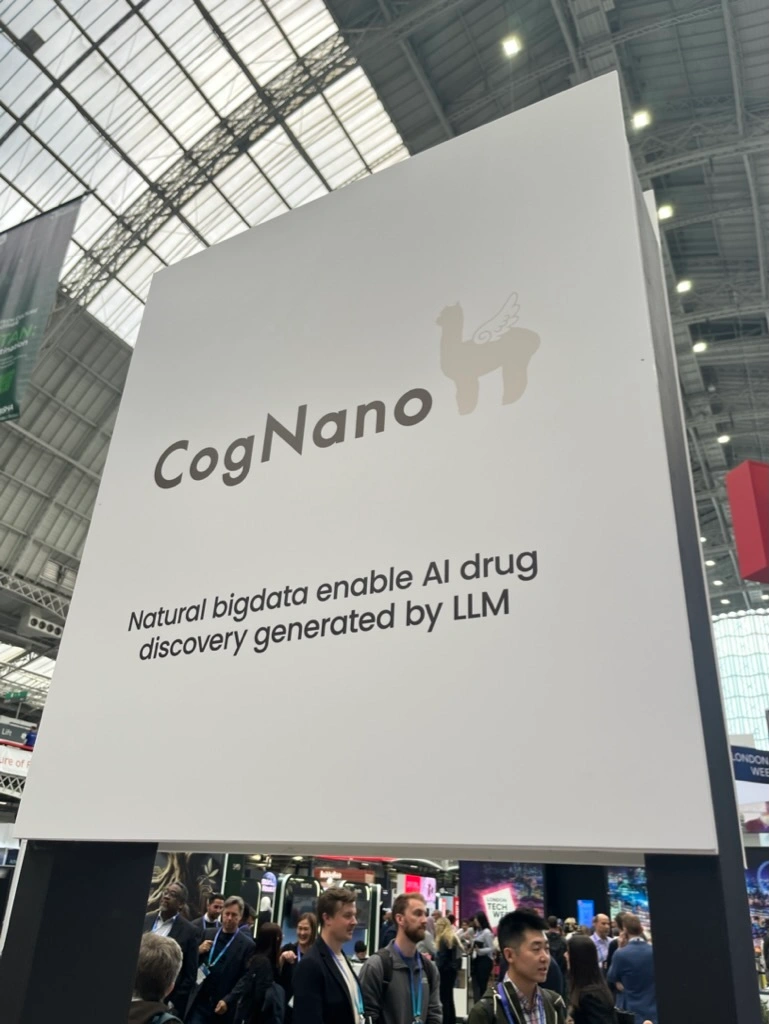
London-based JETRO staff, including Mr. Ito, Ms. Yoshida, Mr. Sakakihara and Mr. Hasui were very helpful in the online preparation for my presentation. When I timidly asked them about the attendees of the business rally and whether my biotech pitch would appeal to them, they reassured me. They said that the online pitch videos in Japanese that COGNANO had posted on its corporate website would be perfectly suitable.
The JETRO staff went to great lengths to provide valuable advice and guidance on my English pitch. They truly left no stone unturned! I’m very grateful for their diligent efforts in helping me prepare for the booth, the event, and everything else. I was so engrossed in the preparation that the departure date almost slipped my mind. With the words of encouragement from JETRO staff echoing in my thoughts. I left Japan for London.
I embarked on two missions in London. The first was to present the unprecedented value generated by the fusion of biology, specifically antibodies, and big data. This unique combination is a world-first, offering immense potential.
The second mission was to communicate the complexity and resource-intensive nature of our pioneering project. Given its demanding nature in terms of time and financial investment, we are actively seeking the financial and technological collaborations, in particular, financial partnership to help us advance this groundbreaking initiative.
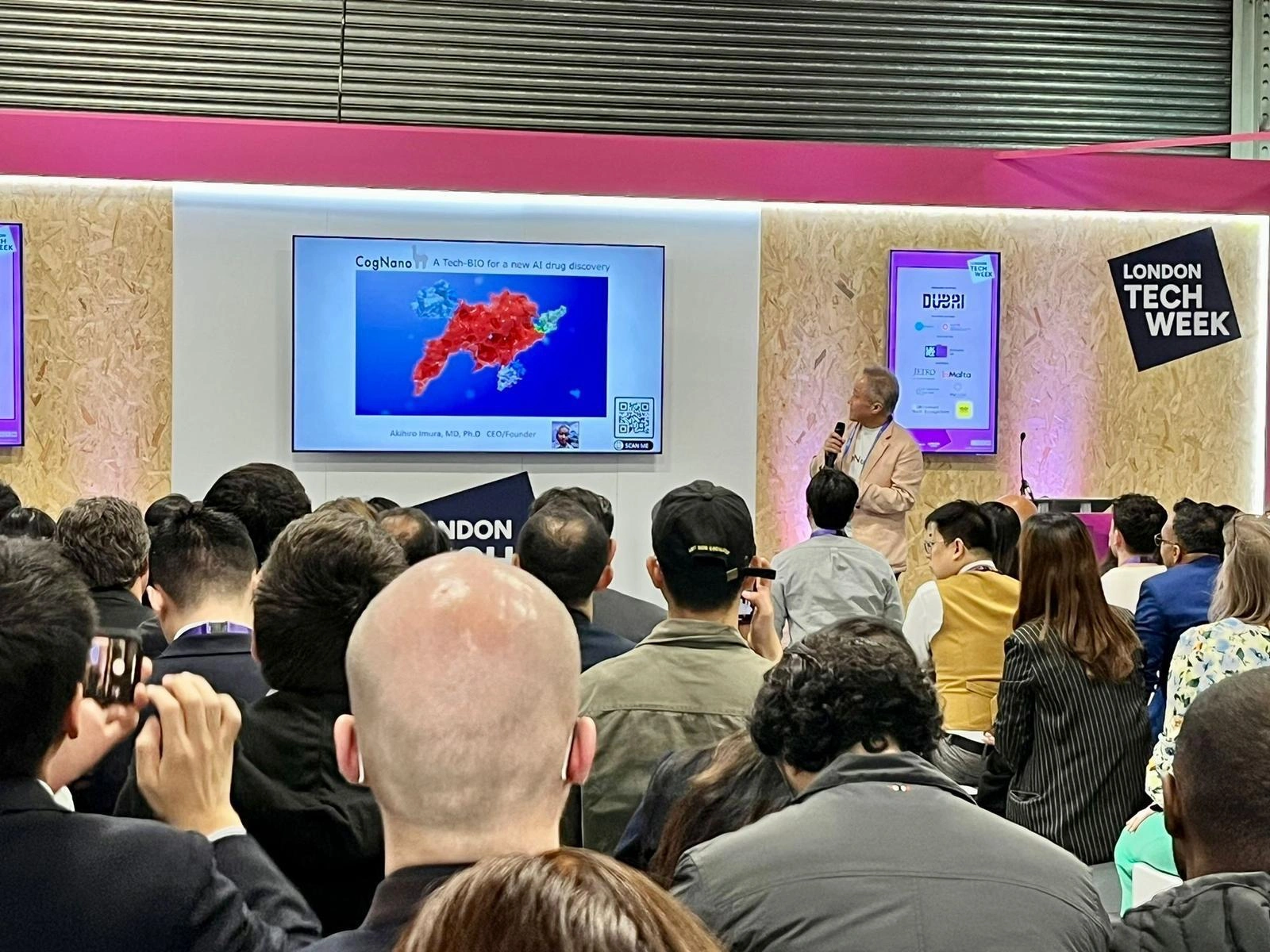
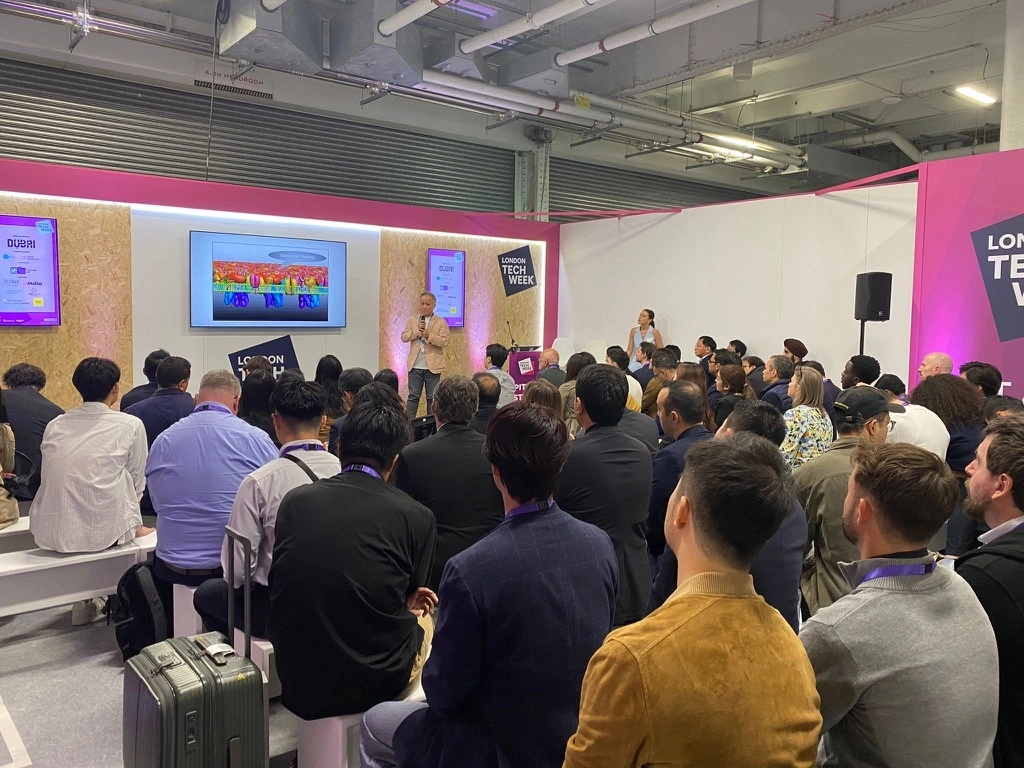
The venue was brimming with a diverse crowd of attendees. This included students, business professionals, researchers and investors, culminating in an impressive total turnout of 15 thousand individuals. Given the majority of them were business professionals engaged in IT and machine learning, the concept of antibody data was a novel introduction for them.
Although I was able to present only a fraction of COGNANO’s accomplishment, the potential of Large Language Model (LLM) in advancing drug delivery and healthcare piqued the audience’s interest. It was no surprise that our booth welcomed so many curious visitors following the presentation.
While the biotech sector has already seen the application of Artificial Intelligence (AI) in the linguistic processing of medical records and scientific papers, the notion of utilizing hardcore natural information, such as the amino acid sequence of an antibody (analogous to the DNA sequence of an antibody gene) in AI-driven drug discovery seemed to ignite the scientific curiosity of the London audience. Leave it to the successors of the great British scientists, be it the lineage of Isaac Newton, that of Dr. Watson and Dr. Click or whoever!
A number of IT researchers were engaged in LLM or had familiarity with NeurIPS, the official gathering of AI academics. We were so honored to receive numerous compliments from these individuals, particularly regarding the acceptance of our work for presentation at NeurIPS. Contrary to typical academic meetings, which often see fewer attendees in the early mornings and on the final day, we experienced a pleasant surprise during LTW.
Our booth attracted a continuous stream of intrigued visitors, leading to engaging and spirited discussions throughout the event. It was both inspiring and exciting to witness students and scholars from prestigious institutions like Imperial, Oxford, Cambridge and King’s College, as well as investors and business professionals from around the globe, converging at the event.
Their active participation and engrossing debates with the presenters truly added to the dynamism of the event. These were open-minded young trailblazers, brimming with eagerness to acquire new knowledge and perhaps financial gain as well. They came from every corner the world to London, in search of opportunities.
I realized how much times had changed since my college days when securing internship at a prestigious company or hospital was considered the pinnacle of career options. Eventually, we estimated we had met with more than 150 teams or around 300 attendees, based on the number of QR codes we had scanned. We are truly grateful for the substantial turnout at our booth. As a result, we initiated business discussion with some investors and have also maintained contact with some researchers in the field of biology.
What excited us the most was encountering many tech-savvy individuals who understood that hard-data of natural products could be leveraged in ML. We are thrilled to connect and share values with individuals we would never have had the opportunity to meet if it were not for COGNANO’s current proposal.
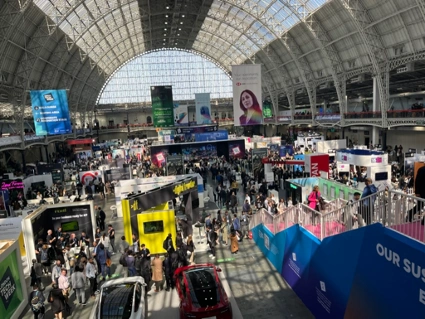
The past few decades have seen a significant progress in biotechnology. These include:
- The development of datasets including the discovery of creatures with single-domain antibodies, like alpaca in 1989, and the universal availability of the next-generation sequencers to the field of biology around 2010,
- The emergence of Large Language Model in IT engineering, which gained a significant boost from the success of OpenAI in 2022.
- A growing trend toward genomic drug discovery, such as mRNA vaccines, and the rise of antibody-based drug such as ADC anti-cancer agent. This trend is underscored by the fact that for the fist-time in over 150 years of pharmaceutical history bio-drugs have outnumbered chemically-produced drugs in FDA approvals.
These trends and advancements have now become familiar to the public, so just hearing one or two keywords is enough for most people to grasp the essence of these progresses.
Looking back on our accomplishment to date, I think it’s fair to say that COGNANO has made a timely proposal that coincided with the emergence of these trends and advancements.
COGNANO’s research is centered around the fascinating interplay between antibodies and antigens. Here are the key concepts behind it:
- Antibody Production: Antibodies are the result of a biological algorithm that selects from an almost infinite array of sequence possibilities.
- Antibody-Antigen Pairing: Each antibody makes a unique one-on-one pair with a specific antigen.
- Amino Acid Sequences: Both antibodies and antigens are composed of amino acid sequences. Interestingly, these sequences can be represented as a series of alphabetical letters.
- Analyzing Interactions: The specific pairing between an antibody and an antigen can be analyzed in a manner similar to language translation, given their sequence representations.
In essence, our research explores the complex ‘language’ of immune response, with the aim of decoding the ‘conversation’ between antibodies and antigens. These concepts are so simple, aren’t they?
I managed to obtain those astonishingly simple concepts after years of hard work and struggle in the realm of medicine and biology. I recall a moment when I stood in silence, feeling utterly helpless, in the presence of my patient who was succumbing to an incurable disease. I also remember the numerous occasions in the biological research where I was perplexed about the conclusions to be drawn from the experimental data in relation to the hypothesis. Perhaps my participation in LTW helped to lessen some of my feelings of helplessness and obsession with linking hypotheses and conclusions. I’m feeling a little liberated, ain’t I?
Given the fact that antibodies can provide huge data as they are being produced in large quantities in response to external invaders, why is it, then, that any other researchers worldwide than COGNANO have never attempted to build a comprehensive data set on antibodies and utilize LLM? There’s been a significant scarcity of reports on data related to antibodies and their target proteins, or labeled data. This is largely due to the complexity of antibody genes. With the exception of a few organisms, these genes are too intricate to decipher, making them unsuitable for the construction of comprehensive big data. Furthermore, since machine learning has been a relative new concept in biology, very few researchers in this field have embarked on constructing big data.
Our research is akin to a mathematical analysis of how molecules interact with each other within the body, resembling decoding messages where a unique letter of the alphabet represents each of 20 different amino acid. Decoding is an algorithm that has been advanced in information warfare. The process consists of four steps; it begins with the collection of data, followed by the comprehension of linguistic characteristics, analysis of frequency, and ends in the evaluation of hypotheses. According to this theory, extensive data set of VHH antibodies encompasses the initial three steps of the biological message decoding process.
The hieroglyphics inscribed on the Rosetta Stone, written in the ancient Egyptian script, were deciphered with the aid of their Greek translations found on the same slab. In essence, the “labeled data” provided by these hieroglyphics were crucial to their successful decoding. Our machine learning endeavor is likened to deciphering messages from the microscopic molecular realm, utilizing the data set of labeled antibodies. The final step is the evaluation of hypotheses, which involves verifying the functions of machine-generated de novo antibodies through direct biological experimentation, or “wet” lab experiments.
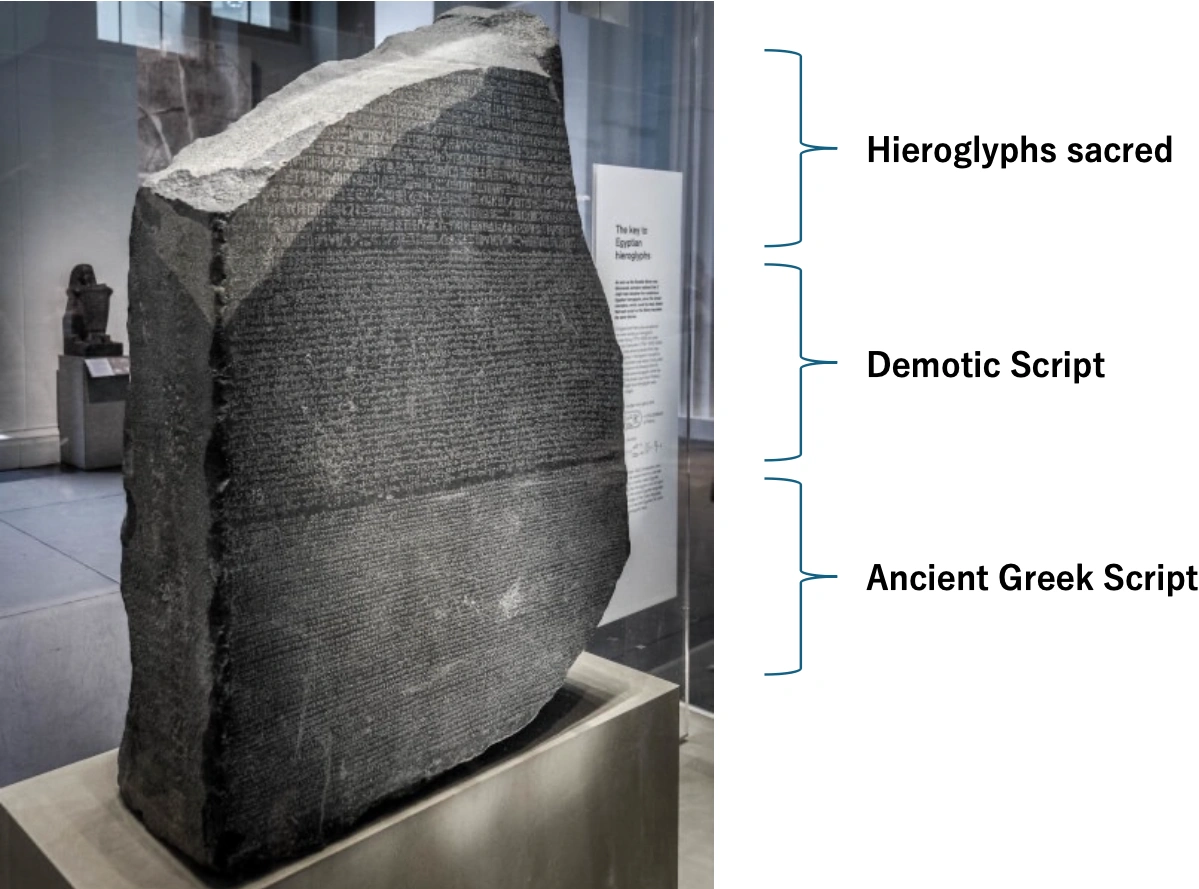
COGNANO are at the forefront, possessing the world’s largest dataset of labeled antibodies. Our efforts are focused on rapidly expanding this data set to solidify our leadership in the field. We aim to publicize our strategic approach in the coming year. Adhering to our mantra that nature is the most reliable teacher, we have diligently followed our policy of using natural data derived from living organisms.
However, requiring wet lab experiments, this method is expected to eventually hit a ceiling in its data production rate. It is anticipated that we may eventually require artificial data from machines that have learned the theory, a concept far beyond my current comprehension as a biologist. This journey should be undertaken alongside fellow explorers who will become part of COGNANO. The Rosetta Stone, unearthed in Egypt, was initially seized by Napoleon French Army, but later confiscated by British Army and now displayed at the British Museum. Well, well …!
The reason why London responded to COGNANO's bio molecular deciphering... That's how much the British love codes. I have a feeling that COGNANO will be able to get along well with the people of this country!
This is edited by Dr. Kimio Fujii for english.